Sustainability Implications of Using Solar Power in the Sultanate of Oman
Info: 8781 words (35 pages) Dissertation
Published: 9th Dec 2019
Sustainability implications of using solar power in the Sultanate of Oman
II – Contents
2 – Review of Existing Literature
2.1 – Basic background on solar cells
2.2 – Solar energy potential in the Sultanate of Oman
2.3 – Current solar power projects in the Sultanate of Oman
2.4 – The Economic cost of solar power utilization
2.5 – The issue with taxation and solar energy
7 – Recommendations for Further Work
1 – Introduction
The Sultanate of Oman, for the past multiple decades, has relied on oil and gas production as its primary source of energy for the country’s electricity appliances. The Sultanate of Oman is located in the in the Middle East, a geographical area well known for receiving high solar irradiance. Ideally, countries in the Middle East would strategize a switch from their current forms of non-renewable and non-sustainable energy production, most commonly oil and gas, to a more sustainable and renewable source of energy such as solar power, as gas and oil reserve capacities are decreasing in a rapid rate. According to Shahriar Shafiee and Erkan Topal [1], natural gas and oil reserves will be diminished by the year 2042.
According to International Renewable Energy Agency (IRENA), close to 60% of GCC’s surface area has excellent suitability for solar PV deployment. And developing just 1% of this area could create almost 470 gigawatts of additional power generation capacity. [2] Throughout the region, as well as some countries in North Africa, current advances have been made in order to shift the primary source of energy from crude oil and gas to more sustainable sources of power generation. Organizations in the Middle East have also been initiated to encourage such progressions. Solar GCC alliance is an organization based in the MENA (Middle East North African) region to encourage its affiliated countries to pursue independent solar development, while simultaneously providing an infrastructure for international collaboration. [3]
Noted examples of such progressions that have been initiated or have already been taken place are [4]:
- Mohammad Bin Rashid Al Maktoum Solar Park, UAE. Once completed in 2030, the 48 sq km park will have a solar capacity of 1GW. The project will cost a total of 3.2 billion dollars.
- Qweira Solar Plant, Jordan. The 75MW plant will be installed in Qweira, Aqaba governorate. Jordan is planning on installing 1,800MW worth of renewable energy projects and connecting them to the national grid by 2018. The project will cost around 750 million dollars.
- Al-Abdaliya ISCC Project, Kuwait. Planned ISCC project at Al-Abdaliya is the largest planned renewable energy project in Kuwait. The scheme was originally proposed to the PTB as part of its unsolicited proposal process by Japan’s Toyota Tsusho. The project will cost a total of 700 million dollars.
- 200MW PV Power Plant, Egypt. Terra Sola and Swiss Terra Nex will build 2GW of PV power plants on a build-own-operate-transfer basis across the country. The plan includes the construction of a 200MW PV module manufacturing facility and an inverter fab to be used for the consortium’s own solar plants. The plan will cost 3.5 billion dollars.
By taking into consideration the range of power generation, the costs, as well as the methodology of solar power generation (privately owned or government/company owned solar farms connected to the grid) stated in the previous projects initiated in the Middle East. If the Sultanate of Oman were to initiate or encourage a project of such magnitude in terms of cost and power generation, it is important to deduce the most sustainable way economically, environmentally, and socially the country can implement a strategy to shift its primary source of energy generation from exploiting crude oil and gas to solar power. This ensures that such strategy meets the needs of the present generation without compromising the needs of the future generations to meet their own needs.
1.1 – Aims and Objectives
The aim of this project is to evaluate the sustainability of using solar power as the primary source of energy in the Sultanate of Oman. The approach of this project will be towards evaluating the three pillars of sustainability regarding the effectiveness of primarily using solar power production in the country in replacement to the country’s current use of oil and gas and its primary sources of energy. The three pillars of sustainability are the economic, environmental and social pillars. [5]
1.2 – Project Planning
To evaluate the economic implications of solar power, the price of a solar powered system in an average household in the UK is used as a point of reference. The power generated by the system as well as the total cost of the system is used as a reference in evaluating costs in the form of the Sultanate of Oman’s form of currency (OMR). Two main strategies used for solar power generation, privately owned and government/company owned, are compared in terms of the differing costs between the two forms of solar power generation such as additional taxes and feed-in tariffs.
To evaluate the environmental implications of solar power, research is done on an existing Life Cycle Analysis (LCA) on the use of solar power as the primary source of energy and compared to another LCA on the use of crude oil and natural gas as the primary source of energy. The Sultanate of Oman primarily exploits oil and gas as its primary source of energy. By comparing the two respective LCAs, is the, out of solar power and oil and gas, is most environmentally sustainable method of energy production is
2 – Review of Existing Literature
The primary research undertaken for the project is based on the existing knowledge of the potential of solar power in the Sultanate of Oman. Basic knowledge of the different types and the cost of solar cells is researched as basic background information. Quantitative data is then collected for the solar irradiance that the country receives on an annual basis. Further research is also done on the existing steps that the sultanate has already undertaken to utilize the potential of solar power usage in the country. This includes solar power projects that have already been initiated or completed on a local level such as in small villages or in tourist destinations. Research is also done on whether the government has already set goals and objectives to guide the country towards using renewable resources, more specifically solar energy, as a replacement to oil and gas production for the country’s primary source of energy. Existing literature is used to evaluate the economic and the environmental implications of using solar power, leading up to the construction of a survey to evaluate the social implications of solar power in the Sultanate of Oman while taking into consideration the implications researched of the other two respective pillars of sustainability.
2.1 – Basic background on solar cells
The technology used to convert light directly into electrical energy is called a Photovoltaic Solar Cell. Solar cells that are electrically connected and that are mounted in a structure or frame is called a module. A module is designed to supply a specific amount of electricity at a certain voltage. How much light strikes a module will correspond to the amount of current that can be generated by it. Modules that are electrically connected are called arrays. The current produced by photovoltaic cells is in the form of direct current.When it comes to electricity production solar cells can either be captured by implementing solar arrays on top of buildings/houses, or in the form of solar power plants. [6]
Figure 1 [6]
The relationship between a solar cell, module, and an array
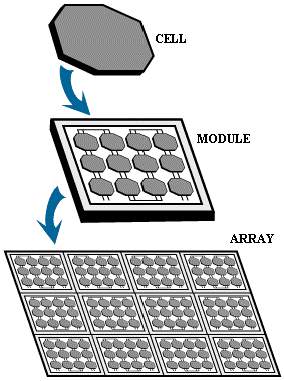
2.2 – Solar energy potential in the Sultanate of Oman
Below is a table that displays the solar irradiance that the Sultanate of Oman receives per month on an annual basis, according to Adel Gastli and Yassine Charabi [7]. These values are assumed based on the amount of Wh/m2/day a 3000m x 3000m solar array receives when multiples of them are distributed throughout the area of the country.
Table 1 [7]
Solar irradiance in the Sultanate of Oman per month for an average annual year (Wh/m2/day)
| Value | Month | |||||||||||
| Jan | Feb | Mar | Apr | May | June | July | Aug | Sep | Oct | Nov | Dec | |
| Min | 2375 | 2929 | 3805 | 4808 | 5458 | 5589 | 5587 | 5564 | 5508 | 4095 | 3018 | 2443 |
| Max | 4078 | 4696 | 5560 | 6415 | 7050 | 7304 | 7340 | 7150 | 6618 | 5816 | 4857 | 4157 |
| Mean | 2770 | 3338 | 4202 | 5130 | 5673 | 5869 | 5884 | 5756 | 5305 | 4479 | 3491 | 2840 |
As seen in Table 1, the highest solar irradiance per day is obtained during the month of July, ranging between 5500-6000 Wh/m2/day, and the least amount of solar irradiance per day is obtained during the month of January, ranging between 2500-3000 Wh/m2/day. This shows a very high potential for solar energy usage in the country.
Below, Figure 3, is a figure that displays the total solar radiation per annum as well as the slope classification throughout the entire area of the country:
Figure 2 [7]
Solar radiation density per annum (MWh/m2) and the slopes classification over the land of Oman
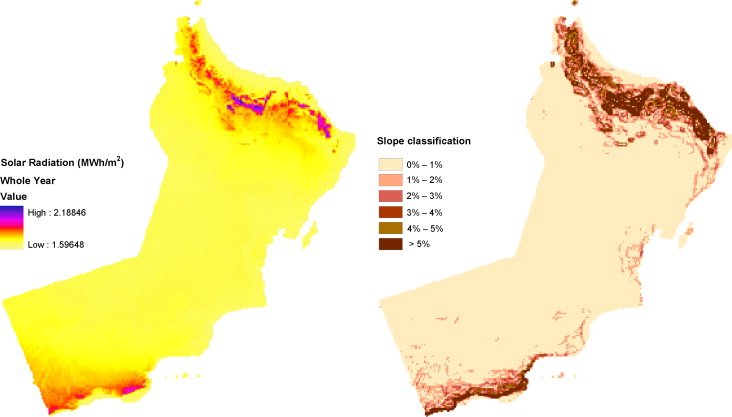
A large portion of the lands in Oman have similar solar irradiance as well as low slope classifications (of under 1%) throughout the land of the country. This displays the ease of implementing photovoltaic technologies across the country due to the lack of need to induce large amounts of costs to flatten the lands. Also, this removes the need to implement inclined concentrating PV cells for the majority of the land in the country.
2.3 – Current solar power projects in the Sultanate of Oman
As of currently, the Sultanate of Oman is implementing solar energy applications for street lighting, traffic lights, and telephones in remote areas. According to A.H. Al-Badi et al. [8], The Authority for Electricity Regulation in Oman has confirmed six renewable energy projects, four of which are solar power projects: A 100kW PV solar project in Hij, a 292kW solar project in Al Maysonah, a 1500 kW project at a TBC location, and a 28kW solar project in Al Mathfa. The other two renewable energy projects are of the utilization of wind power: a 500kW wind project in Masirah Island, and a 4200kW wind project in Thumrait. [8] All six projects will cost approximately 8.1 million OMR or 15.7 million GBP. If all six projects are implemented, they will collectively reduce the annual diesel fuel consumption by 3.1 million litres per year and prevent the production of 8298 metric tonnes of CO2 production [8].
As far as governmental campaigns, the country’s Supreme Council for Planning is proposing a “Vision 2020” policy that guides the country towards a more sustainable and diverse economy. One of the goals of the campaign is to produce 10% of the country’s total electricity requirements from renewable energy resources by the year 2020 [9]. This indicates the government’s recognition of solar energy potential in the country and it is evident that the sultanate is striving towards the exploitation of solar power for the country’s electricity appliances.
2.4 – The Economic cost of solar power utilization
The average household in the UK would require around 3kW of solar power generation. A 3kW solar panel system would cost anywhere from £4,000-£6,000 (British) depending on the type and quality of the solar panels used [10]. However, money can still be earned from owning a private solar power system. The Feed-in Tariff scheme in the UK allows individuals to receive money for the electricity they generate. The owner of a standard stand-alone solar system of up to 5kW will receive a feed-in tariff rate of 0.23p/kWh [11]. Owning a privately owned solar panel system will also cut down the total costs of energy bills. This is because the electricity you use when the solar panels are active is cost-free [10]. This ultimately concludes the fact that a profit can be made from privately owning a solar power utilization system depending on the size of the system used as seen in Figure 2.
Figure 3 [11]
Estimated installation Cost and Profit after 20 years according to the Solar Panel Capacity

The payback period of a £4000-6000 (British) investment in a 3kW solar panel system, by taking into account Feed-In Tariff rates and the reduction in total energy bills, the return on investment (RIV) per year is stated to be £570 (British) [10]. This is equivalent to a payback period of 7 to 10.5 years, calculated by dividing the total investment over the stated RIV per year.
2.5 – The issue with taxation and solar energy
Oman does not implement a Value Added Tax system as of today. However, on the 5th of November 2016, the country’s Ministry of Finance announced that a VAT system will be implemented in the country in the beginning of 2018. The percentage has not been confirmed but it is predicted to be around 5%. [12]
There is currently a crisis in the UK where business rates paid on solar power have recently increased by 800%, forcing business to pay a larger amount of money that what they initially anticipated to provide electricity through solar power. This has stirred a lot of controversy amongst businesses in the UK who rely on solar energy for electricity production, initiating movements such as “Stop the Solar Tax Hike”. [13] Because of the large financial demand for the production on solar cells, if the Sultanate of Oman was to implement solar energy as the primary energy source in the country within the next few years, it would lead to an even higher increase on the planned VAT percentage of 5% to possibly up to two figures.
This is something that needs to be considered from both an economic and social perspective. Businesses would have to increase their budget to pay taxation on solar power compared to currently paying zero taxation on current electricity production from oil and natural gas. This could hurt specifically smaller businesses in the country. From a social perspective, how willing would the citizens be to not only start paying for VAT but to also pay on top of that within the next few years if solar power was introduced?
3 – Methodology
A survey has been constructed to evaluate the social implications of exploiting solar power as the primary source of energy in the Sultanate of Oman. The survey has been planned to begin on the 26th of March 2018, with a set duration period of three weeks, until the 15th of April 2018. It is made sure that the population of the study is restricted solely to residents of the sultanate, of both Omani and non-Omani citizens. To accommodate for non-English readers, an Arabic translation of the survey is also published. The target population size is set at 100 responses, with the incentive of additional responses being welcomed and acceptable. Google Forms has been used to both create and publish the survey to the public. All the feedback and responses to the study are recorded and password-protected through a Google email account accessed by the creator of the survey. Below are the questions that have been asked in the survey to be answered by the population. A total of 15 questions are to be answered in the study. Under each stated question is a brief explanation of why it has been asked as well as the objectives hoping to be achieved.
3.1 – Survey questions
- Please select your age group
This question has been asked to analyse the differing responses in relation to the demographic of the population. It is used to take into consideration the differing opinions of younger age groups compared to older age groups throughout the study.
- What is your current employment status?
This question has been asked to analyse the differing responses in relation to the demographic of the population. It is used to take into consideration the different responses throughout the study based on the employment status of the respondent.
- Please select your governorate of residence
This question has been asked to analyse the differing responses in relation to the demographic of the population. It is used to compare the differing responses between residents living in the capital city of Muscat, in comparison to the other governorates of residence of the country
- Are you an Omani-born citizen?
This question has been asked to analyse the differing responses in relation to the demographic of the population. It is used to compare the responses of Omani residents and non-Omani residents living in the area and how they differ from each other.
- Does climate change concern you?
One of many factors of the encouragement of switching to renewable energy such as solar power from conventional power generation (oil and gas), is the direct impact fossil fuel production has on climate change through the enhanced greenhouse effect. The population is thereby asked whether this factor concerns them or not.
- Is it important that we act on addressing climate change in the sultanate urgently?
Following up on the previous question, it is then asked whether addressing climate change in the Sultanate of Oman is an issue is of importance. This question is asked based on a 1 to 5 scale.
- Do you agree that the exploitation of oil and gas in the country is a major contribution to recent climate change in the sultanate?
In reference to question 5 of the study, the population is asked whether they believe there is an interlink between the exploitation of oil and gas as the primary source of energy in the country and recent climate change in the country.
- How important is it to you that the Sultanate acts on shifting from non-renewable resources to renewable energy resources as the primary source of energy in the country to reduce climate change?
Following up to the previous question, this question is asked based on whether the contribution of oil and gas exploitation to climate change means that the country should shift its interest towards introducing solar power as the primary source of energy in the country. This question is asked based on a 1 to 5 scale.
- The Sultanate of Oman receives high amounts of solar irradiation of up to 5500-6000 Wh/m squared per day during the months of the summer. How much do you agree that the country should exploit this high amount of solar irradiation to make solar power as the primary source of energy in the sultanate within the next two decades?
By referring to section 2.2, the solar irradiation in the sultanate is mentioned to justify whether the population agrees with exploiting such high amoutns of solar irradiation to make solar power a priority in the sultanate. This question is asked based on a 1 to 5 scale.
- How much are you willing to spend on an initial investment to make your home solar powered?
In reference to section 2.4, a typical 3kW solar panel system would require an initial of investment of 4000 to 6000 GBP, which exchanges to 2127 to 3191 OMR (Omani Rials) as of February 11th, 2018 [15]. In the question, different selections from 0 OMR to 4000 OMR are asked as to how much residents are willing to spend on such an investment.
- What is the maximum payback time you would be willing to allow for such investment?
The population is asked how much time they are willing to wait until they receive a complete return in investment on a solar power system. In reference to section 2.4, the payback period of a 3kW solar panel system is 7 to 10.5 years depending on the initial investment made. In the question, different selections from under 2 years to over 8 years are asked as the possible answers to the question
- Would you rather personally set up your own solar powered system at your home for a potentially cheaper investment or pay a higher amount of money for your contribution to a privately owned or a government based solar power station that will be connected to the country’s electric grid?
Due to additional costs needed for the government to implement the solar powered system to the grid and to distribute it throughout the country, it would require residents to pay additional tax charges in comparison to residents setting up privately owned solar panel systems in their home. This is taken into account in regard to whether the residents would prefer a privately owned system for a cheaper investment, or a government based solar power station for a larger amount of money
- In the case of privately owned or government based solar powered stations, substantially large amounts of land required will inevitably lead to an increase in the price of local land in the country. How much does this personally affect your persuasion to remain to pursue a switch to solar power?
Introducing solar powered stations in the country would require a vast amount of land. This causes a reduction in the supply of land in the country, thus increasing it’s demand, ultimately leading to the value of local land in the country increasing. The population is thereby asked whether this affects them or not.
- Are you willing to pay additional tax rates for your electricity consumption after a switch to solar powered energy?
Referring to section 2.5, the introduction of VAT in the Sultanate of Oman is set to take place at the beginning of the annual year of 2018. The importing and implementation of solar panels will cause an increase to the Value-Added Tax set to be introduced in the country due to the importing and consumption of goods and services (solar panels in this case, where there is a large possibility of them being imported). The population is thereby asked whether they are willing to pay for such additional taxes.
- Are you willing to reduce your current electricity consumption to support the complete exclusive use of solar panels as energy generation?
Solar power systems produce a set amount of power (3kW for example) in comparison to oil and gas. This means that the power produced by the systems are more limited in comparison to crude oil and natural gas power stations and rigs. The population is asked whether they are willing to sacrifice their unneeded electricity consumption in order to support the exclusivity of solar power as the primary source of energy in the country.
4 – Results and Analysis
Below are the results of the survey broken down per question shown in the form of either a pie chart or a bar chart, depending on how the answers of each question are desired to be broken down. Following up is the analysis of the data per question, written in the form of a paragraph long response. Depending on the question, the analysis is taken further by analysing the responses of the question based on either/or the age group, employment status, governorate of residence, and Omani and non-Omani citizens. The goal population of the study was set at 100 people. However, the number of respondents to the survey has exceeded the goal population and has reached a total of 111 people.
- Please select your age group
Figure 4
Answer breakdown to question one
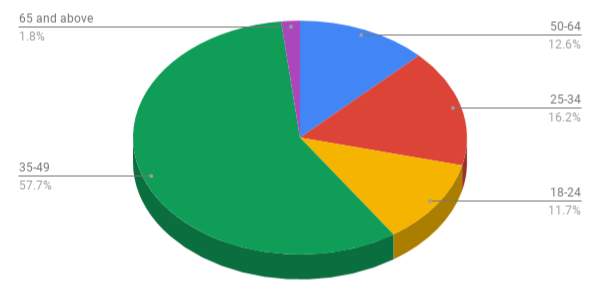
By analysing the responses of the population of the study in Figure 4, it is evident that the majority the respondents fall into the 35-49 age group. This is a positive outcome since individuals in this age group are more likely to be more socio-economically stable in comparison to other age groups between 18-34 and 50-65+. This concludes a more realistic outcome for the questions of the study and it reduces the need of eliminating outliers based on certain age groups that have a lower socio-economic status. As calculated from Figure 4, 86.6% of the study’s population is under the age of 50. This means that the respondents fall below the life expectancy age of 73.8 for men, and 78.9 for women in the country, according to Prof Joshua A Salomon (et. Al) [16], by at least 23.8 years for men, and 28.9 years for women. This means that 86.6% of the respondents of the study will last another generation, authorizing the sustainability of the study.
- What is your current employment status?
Figure 5
Answer breakdown to question two

By analysing the breakdown of the employment status of the population as seen in Figure 5, it is evident that 76.6%, the majority, of the respondents of the question are employed, in either the public sector or in the government. This reduces the need of filtering out students, unemployed, and retired respondents unless necessary. The majority of the respondents work in the public sector. This is significant to take into consideration since public sector employees earn less than private sector employees in the sultanate [17]. This might bias the economic based questions, questions 10 to 14, leading to a possibly less desirable outcome.
- Please select your governorate of residence
Figure 6
Answer breakdown to question three
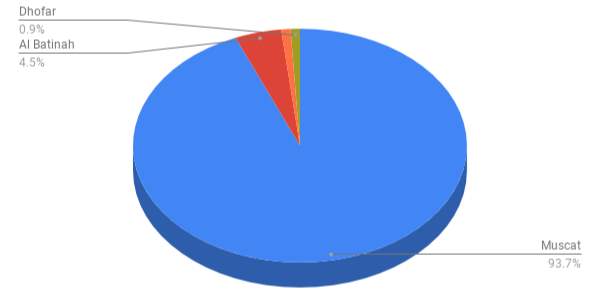
By analysing the breakdown of the governorate of residence of the population of the study, the majority of the respondents live in the capital governorate of Muscat. This is because the survey has been distributed relatively local to the capital city of Muscat. This might be a major limiting factor in regard to the legitimacy of the study on a national scale. However, it is important to note that almost 50% of the population in the Sultanate of Oman live in either the governorate of Muscat or in the coastal regions of Al Batinah [17]. But, it is also important to keep in mind that there are 5 other governorates of which its residents have not taken part in the study: Ash Sharqiyah, Al Dhahirah, Al Buraimi, Al Wusta, and Musandam. It still stands that due to the vast majority of the population of the study are located in the governorate of Muscat, the study is deemed legitimate based on the demands of the residents living in the capital city of the Sultanate of Oman.
- Are you an Omani-born citizen?
Figure 7
Answer breakdown to question four
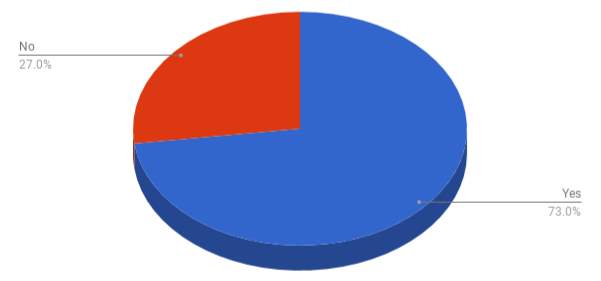
Most of the residents that have responded to the study are Omani born residents, 73%. It is important to consider that this is not completely reflective to the demographic of the Omani population. As of May 2015, the foreign population of Oman stands at 44.2%, according to Françoise De Bel-Air [18]. The foreign population of this study is 27%. By comparing the percentage of the foreigners of the study and the Omani population, it is obvious to see that both are consistent to be the minority. This ensures the legitimacy of the study in reflection to the demographic of the Omani population when comparing foreign to national residents.
- Does climate change concern you?
Figure 8
Answer breakdown to question five
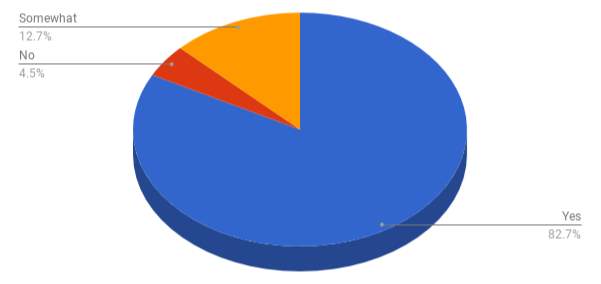
The majority of the population in the study accept that climate change is a concern to them. Only 4.5% of the population disagree that climate change is a concern. This is reflective of the ethical and moral values of the Omani population. They agree that climate change is a concern and therefore strategies must be introduced to reduce its impact.
- Is it important that we act on addressing climate change in the sultanate urgently?
Figure 9
Answer breakdown to question six
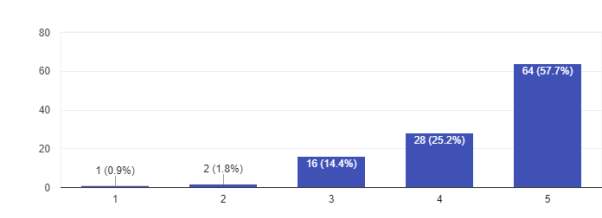
This question has been asked on a 1 to 5 scale, 1 being not important, 5 being extremely important. The majority of the population in the study, 57.7% as seen in Figure 9, has responded that urgently addressing climate change in the sultanate is extremely important. They are aware of the impacts of factors that contribute to global warming such as the enhanced greenhouse effect mainly caused by the increase in carbon dioxide (CO2) in the atmosphere. One of the factors of this increase is the exploitation of crude oil and natural gas as a means of energy production.
- Do you agree that the exploitation of oil and gas in the country is a major contribution to recent climate change in the sultanate?
Figure 10
Answer breakdown to question seven
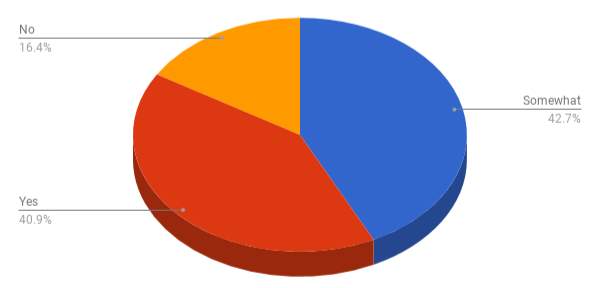
As seen in Figure 10, only 40.9% of the respondents to the survey agree that the exploitation of oil and gas in the country is a major contribution to climate change in the sultanate. 42.7% of the population somewhat agree. This is an interesting observation to make considering the extraction of fossil fuels contribute to a large proportion of carbon dioxide emissions. Carbon dioxide emissions contribute to the enhanced greenhouse effect, causing an increase in greenhouse gases in the atmosphere, contributing to climate change in the sultanate. It is concluded that only a large minority of the Omani population are aware of this phenomenon, which brings into questioning whether there is enough awareness of the contribution of fossil fuel combustion (in this case the exploitation of oil and gas) in the Sultanate of Oman. Perhaps this explains why the country continues to exploit oil and gas as the primary source of energy in the country rather than taking into consideration other alternatives.
- How important is it to you that the Sultanate acts on shifting from non-renewable resources to renewable energy resources as the primary source of energy in the country to reduce climate change?
Figure 11
Answer breakdown to question eight
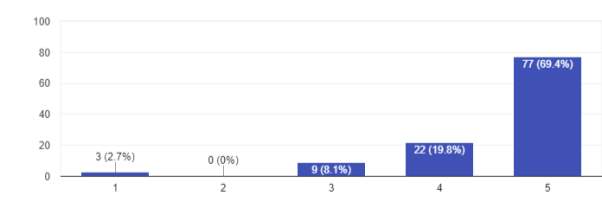
This question has been asked on a 1 to 5 scale, 1 being not important, 5 being extremely important. In contradiction to the response and the analysis of question 7 of the survey, by analysing Figure 11 as the breakdown of the feedback to question 8, the majority of the population of the survey, 69.4%, agree that it is extremely important that the sultanate acts on shifting from non-renewable resources to renewable energy resources in the attempt to reduce climate change in the country. This ensures and confirms that the majority of the population in the sultanate are aware that a shift towards a non-renewable energy source as opposed to oil and gas would be an environmentally sustainable solution in regard to reducing the impact of climate change in the country.
- The Sultanate of Oman receives high amounts of solar irradiation of up to 5500-6000 Wh/m squared per day during the months of the summer. How much do you agree that the country should exploit this high amount of solar irradiation to make solar power as the primary source of energy in the sultanate within the next two decades?
Figure 12
Answer breakdown to question nine
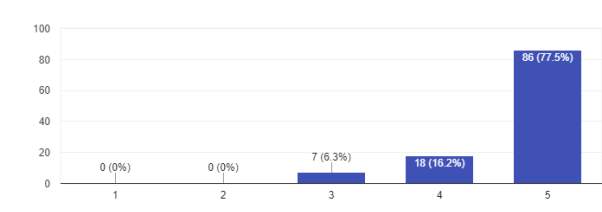
This question has been asked on a 1 to 5 scale, 1 being fully disagree, 5 being fully agree. The vast majority of the population in the study, 77.5%, agree that the high amount of solar irradiation that the country experienced, as referenced in the question, should be exploited to make solar power the primary source of energy in the sultanate within the next twenty years. It is clear to see that most of the Omani population agree that crude oil and gas reserves are going to be diminished within the next generation [1], and therefore an alternative should be taken advantage of as soon as possible, in this case two decades as referenced in the study. The population is aware of the high potential of solar power exploitation in the country.
- How much are you willing to spend on an initial investment to make your home solar powered?
Figure 13
Answer breakdown to question ten
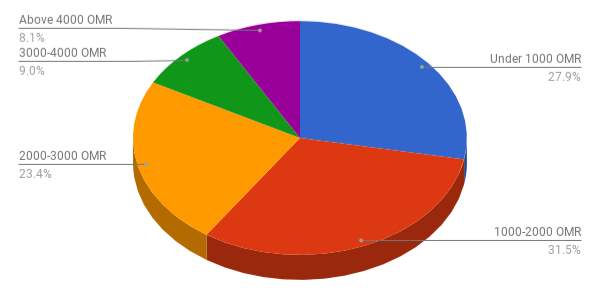
By analysing the response of question 10 of the study, it is evident that only the large minority of the population, 40.5%, are willing to spend above 2000 OMR (Omani Rials) as an initial investment to make their home solar powered. In reference to the analysis of question 10 in section 3.1, the minimum investment requirement to power a 3kW home is approximately 2127 OMR. This means that most of the population in the study are not willing to invest the minimum amount of money to successfully power a typical home with solar panels in the Sultanate of Oman.
The demographics of the population of the study are restricted to the groups with the highest socio-economic status, the age group of 35-49 that are working in the public sector, and the data is analysed again:
Figure 14
Answer breakdown to question ten – specific to the age group of 35-49 years working in the private sector
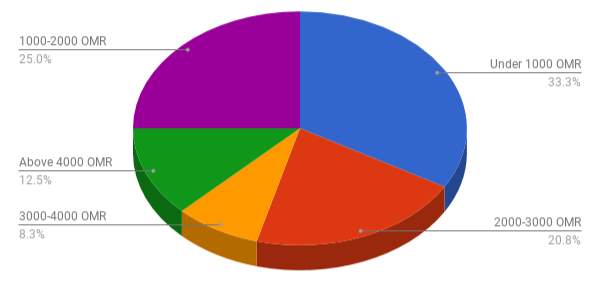
The percentage of 35-49 year olds working in the private sector, the population demographic with the highest socio-economic status, that are willing to invest the minimum amount to make their home solar powered is still the minority, at 41.6%, only 1.1% more than the entire population of the study. This raises economic concerns of the eligibility of solar power generation in the country. It is important to consider that there is a possibility for a lack of awareness of the luxuriousness of solar panels within the Omani population. Solar panels are expensive. This might lead to the population reacting with shock to the values presented to them in this question, due to their lack of awareness.
- What is the maximum payback time you would be willing to allow for such investment?
Figure 15
Answer breakdown to question eleven
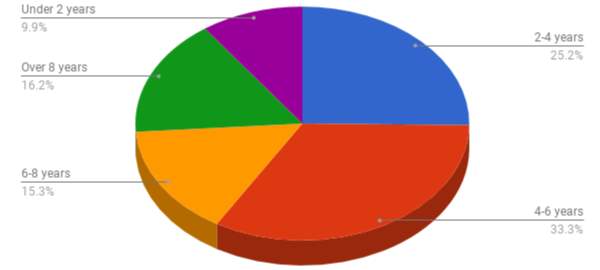
In response to question 11 of the survey, only the minority of the population of the study, 31.5%, are willing to accept the payback period of at least 7 years required for the investment of a typical 3kW solar powered system, as referred in section 2.4. However, this does not filter out the population who are not willing to make the actual investment into a typical 3kW solar panel system. Therefore, below is a chart representing the population that are willing to make the minimum investment in a 3kW solar panel system:
Figure 16
Answer breakdown to question eleven – specific to the population who are willing to meet the minimum requirement of 2127 OMR for a 3kW solar panel system
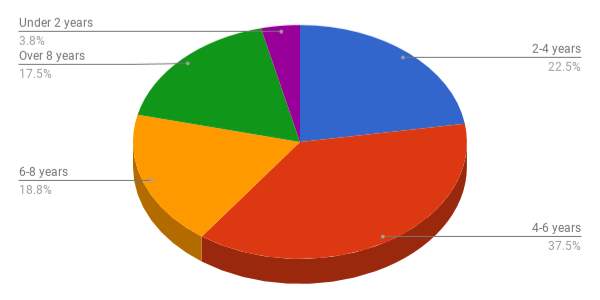
By analysing Figure 16, only 36.3% of the people that satisfy the minimum investment requirement of 2127 OMR are willing to wait for the minimum payback period of 7 years for the return on their investment. Again, in reference back to the feedback for question 10, there is a possibility for a lack of awareness of the feed-in tariff rates and how much energy solar panels actually save in comparison to energy production from crude oil and gas. This might be caused by either a lack of awareness or interpersonal economic issues.
- Would you rather personally set up your own solar powered system at your home for a potentially cheaper investment or pay a higher amount of money for your contribution to a privately owned or a government based solar power station that will be connected to the country’s electric grid?
Figure 17
Answer breakdown to question twelve
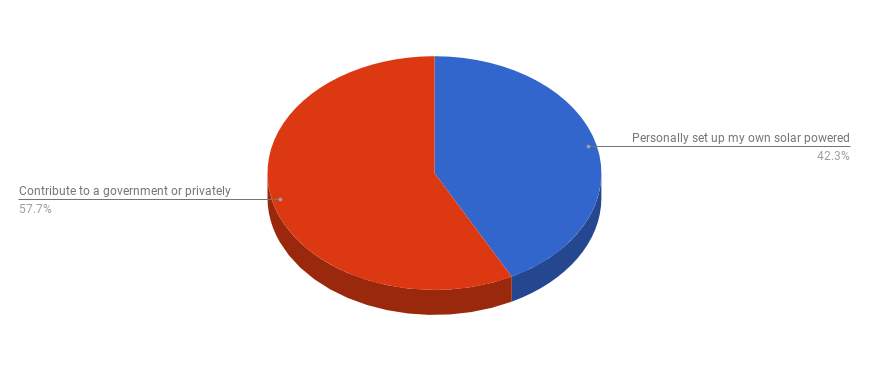
By analysing Figure 17, the study shows that the majority of the population would prefer to contribute to a government/private solar power station that will be connected to the country’s grid. The feedback to this question contradicts the responses to both question 10 and 11, where the majority of the population are not willing to spend the minimum amount of money required for a cheaper investment for a solar powered system at home. The investment required for a solar power station is higher due to the extra costs for the electricity distribution needed from the solar farm to the residence throughout the country as well as added VAT taxes due to the electricity consumption from the solar panels, as well as taxes payed for the possible importing of solar panels into the country.
- In the case of privately owned or government based solar powered stations, substantially large amounts of land required will inevitably lead to an increase in the price of local land in the country. How much does this personally affect your persuasion to remain to pursue a switch to solar power?
Figure 18
Answer breakdown to question thirteen
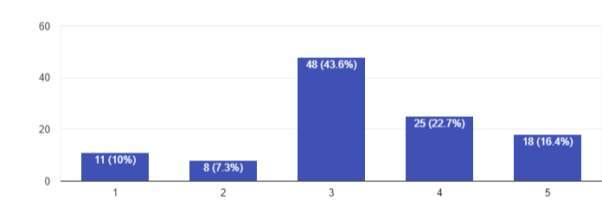
This question has been asked on a 1 to 5 scale, 1 being does not concern me, 5 being fully concerns me. By breaking down the response to question 13, it is deduced that the majority of the population, 60.9%, either feel indifferent (3) or are not concerned with the increase in the price of the local land (1 and 2). Therefore, the majority population are not affected by the indirect economic impacts of implementing solar power in the country. By linking this question with the previous question in the study (question 12), it is evident that a solar farm, from an economic stand point, is preferred over an private home solar panel system.
- Are you willing to pay additional tax rates for your electricity consumption after a switch to solar powered energy?
Figure 19
Answer breakdown to question fourteen
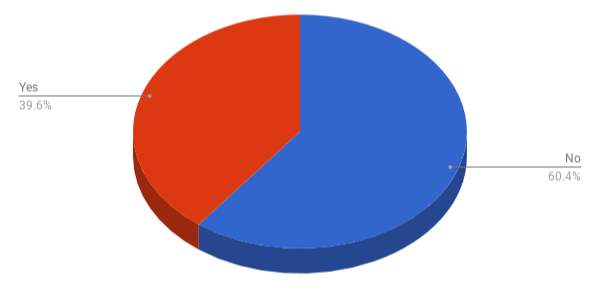
By breaking down the response to question 14 through the analysis of Figure 19, it is deduced that the majority of the population of the study, 60.4%, are not willing to pay additional taxes for electricity consumption following a switch to solar energy. This is a major concern since VAT taxes and trading taxes for importing the solar panels are required to be introduced with solar power generation.
The demographics of the population of the study are restricted to the groups with the highest socio-economic status, the age group of 35-49 that are working in the public sector, and the data is analysed again:
Figure 20
Answer breakdown to question fourteen – specific to the age group of 35-49 years working in the private sector
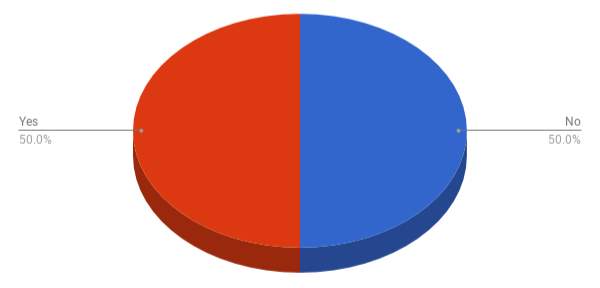
The percentage of 35-49 year olds working in the private sector, the population demographic with the highest socio-economic status, that are willing to pay additional tax rates for energy consumption after a switch to solar power are even to the individuals in this demographic who are not willing to pay additional taxes. In comparison to the general population, as seen in Figure 19, this is a 10.4% increase. However, this means that even the most economically stable individuals in the Omani population, according to the study, have equally differing opinions on whether they should pay essential taxes for implementing solar power in the country. When analysing the economic implications of implementing solar power in the Sultanate of Oman, the feedback to this question is important to discuss.
- Are you willing to reduce your current electricity consumption to support the complete exclusive use of solar panels as energy generation?
Figure 21
Answer breakdown to question fifteen
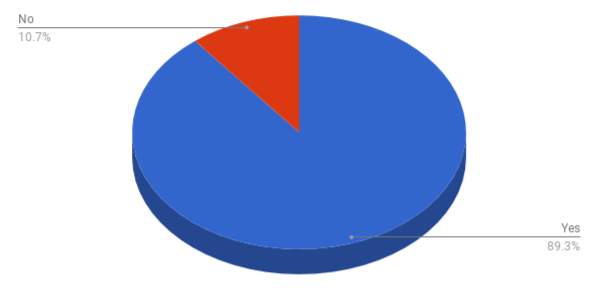
By analysing the response to question fifteen, as seen in Figure 21, the study shows that the majority of the population are willing to reduce their electricity consumption to satisfy the limited energy production that solar panels can generate. Solar panels, in comparison to oil and gas, generate a more limited amount of energy. According to the study, the vast majority of the Omani population are willing to reduce their electricity consumption in their homes, ensuring the likelihood of completely replacing oil and gas to solar power is a possibility from a social perspective.
5 – Discussion
6 – Conclusion
7 – Recommendations for Further Work
8 – References
[1] SHAHRIAR SHAFIEE and ERKAN TOPAL. Energy Policy: Volume 37, Issue 1, Pages 181-189, (2009)
[2] GORD. What is the Solar Energy Potential in the GCC?, [online], January 15th 2017, accessed: [14/10/17], http://www.gord.qa/blog-details/8/what-is-the-solar-energy-potential-in-the-gcc
[3] SOLAR GCC ALLIANCE. Oman Solar, [online], February 22nd 2014, [accessed: 15/10/17], http://www.solargcc.com/oman-solar/
[4] THE BIG 5 HUB. Top 10 MENA renewable energy projects, [online], June 17th 2015, [accessed: 17/10/17], https://www.thebig5hub.com/galleries/top-10-mena-renewable-energy-projects/
[5] CIRCULAR ECOLOGY. Sustainability and Sustainable Development, [online], July 9th 2014, [accessed: 18/10/17], http://www.circularecology.com/sustainability-and-sustainable-development.html#.Wi3Brd9l9PY
[6] NASA. How do Photovoltaics Work? | Science Mission Directorate, [online], August 6th 2008, [accessed: 18/10/17], https://science.nasa.gov/science-news/science-at-nasa/2002/solarcells
[7] ADEL GASTLI and YASSINE CHARABI. Renewable and Sustainable Energy Reviews: Volume 14, Issue 2, Pages 790-797, (2010)
[8] M.H. ALBADI, E.F. EL-SAADANY, and H.A. ALBADI. Energy: Volume 34, Issue 10, Pages 1579-1586, (2009)
[9] SULTANATE OF OMAN, SUPREME COUNCIL OF PLANNING. Vision 2020, [online], January 24th 2016, [accessed: 21/10/17], http://www.solargcc.com/oman-solar/
[10] GREENMATCH. What Is the Installation Cost for Solar Panels?, [online], August 5th 2015, [accessed: 7/11/17], https://www.greenmatch.co.uk/blog/2014/08/what-is-the-installation-cost-for-solar-panels
[11] OFGEM. Feed-In Tarrif (FIT) rates, [online], July 28th 2016, [accessed: 7/11/17], https://www.ofgem.gov.uk/environmental-programmes/fit/fit-tariff-rates
[12] DELLOITE OMAN. VAT 2018 Implementation, [online], April 1st 2017, [accessed: 1/12/17], https://www2.deloitte.com/om/en/pages/tax/articles/vat-gcc-2018-oman-vat-implementation.html
[13] SOLAR TRADE ASSOCIATION. Big Brands say “Stop The Solar Tax Hike”, December 2nd 2016, accessed 2/12/17], http://www.solar-trade.org.uk/big-brands-say-stop-solar-tax-hike/
[14] EXCHANGE RATE. Exhange rate Pound (United Kingdom) to Rial (Oman), February 11th 2018, [accessed 11/2/2018], https://exchangerate.guru/gbp/omr/
[15] PROF JOSHUA A SALOMON, HAIDON WANG, MICHAEL K FREEMAN, PROF THEO VOS, ABRAHAM D FLAXMAN, PROF ALAN D LOPEZ, and PROF CHRISTOPHER JL MURRAY MD. The Lancet: Volume 380, Issue 9589, Pages 2144-2162, (2012)
[16] TIMES OF OMAN, More Omanis now prefer private sector jobs, [online], June 20th 2015, [accessed: 19/04/18], http://timesofoman.com/article/59303
[17] WORLD POPULATION REVIEW, Oman Population 2018, [online], February 9th 2014, [accessed: 21/04/18], http://worldpopulationreview.com/countries/oman-population/
[18] FRANCOISE DE BEL-AIR. Demography, Migration, and the Labour Market in Oman: Page 3, (2015)
9 – Appendices
Cite This Work
To export a reference to this article please select a referencing stye below:
Related Services
View allRelated Content
All TagsContent relating to: "Sustainability"
Sustainability generally relates to humanity living in a way that is not damaging to the environment, ensuring harmony between civilisation and the Earth's biosphere.
Related Articles
DMCA / Removal Request
If you are the original writer of this dissertation and no longer wish to have your work published on the UKDiss.com website then please:




